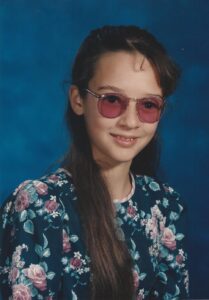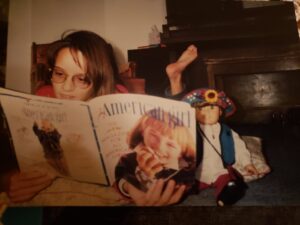

A New Way to View Things
Dancing, swirling, waving …Why don’t these words hold still?
Just lay your hands along the edge of the book. Don’t let the words run away! Closer— Closer— even closer —- That’s better only a little light—-awe not so much dancing now!
She was seven, petite, and very inquisitive, very social, and energetic. Her teacher requested a meeting.
“She’s a good student, smart, a little more interested in visiting than learning, I think,” the teacher says. “She might need her eyes tested. She seems to be having trouble looking at the board.”
At the eye doctor’s office, her eyes tested more than 20/20 but with trouble tracking. Some exercises should help. Following a dot on a spinning wheel would make anyone dizzy, I thought. She spent six months of intensive exercise and then came a move to another state.
She is eight now, still petite, inquisitive, and more interested in the social than the learning.
Her new teacher requests a meeting.
“We believe your daughter needs to have some special testing to see why she struggles in class.”
“I thought her grades were fair.”
“Yes, but she seems restless and her spelling is poor. We want you to sign these papers for testing.”
We finally agree. A whole day of testing is done. When we are called in for the results, we are told she is testing three grade levels above in everything but the written language and needs to be in Special Ed classes because there is such a large discrepancy. They feel she might also be borderline ADD (Attention Deficit Disorder). I had taught Special Ed for several years, I knew better.
Time to find a new eye doctor, once again her eyes tested better than 20/20, but the tracking was worse than before.
“There is something else behind this,” the Doctor says, “I’d like you to watch a video.”
We take the video home and watch it, and wonder if they have been watching our daughter trying to read in school. “I wonder what color she needs?”
A few phone calls later, we head right back to the town where we first learned of a possible eye problem. There is a specialist there who might understand what is going on. “Yes, she needs ’Irlen Filters,’” the doctor says. “She has ‘Scotopic Sensitivity Syndrome.’”
In the book “Reading by the Color” Helen Irlen tells how one night while teaching a group of Students in an English as a second language class she could not find any paper so just grabbed a handful of colored papers. She was amazed when the students started trading for their preferred color.
Scotopic Sensitivity Syndrome is a slight form of dyslexia causing a reaction to fluorescent lights. Being under fluorescent lighting and looking at black on white is the worst for my daughter, as the light causes the white to glare and makes the words dance around on the page.
It can cause severe headaches. It can be hereditary. This can be helped by simply wearing colored lenses, sitting between the fluorescent lights, or removing fluorescent lights, using natural light, and writing on colored paper. Her preferred color of paper is green, after several hours of testing her glasses turned out to be a rosy purple tint.
Her sister, who is six years younger, also has Scotopic Sensitivity Syndrome and uses blue paper. They made believers out of their teachers, if either of my daughters took tests on the green or blue paper, their scores would go up, but if teachers forgot and gave them white paper their scores would go down.
Her new glasses arrive. She puts them on — dancing, swirling, and waving with joy as she discovers in amazement the TV is not fuzzy, lights don’t have rays shooting out from them and leaves have a lot of detail. She still prefers to read in the dark, but it is not such a struggle, and the headaches are gone.
Florescent lights have been known to give people headaches, eye strain, and make them jittery. Irlen Filters are not a cure-all but have been known to help people with some forms of dyslexia, borderline ADD, migraines, and some other reading difficulties.
There seems to be much controversy concerning Scotopic Sensitivity Syndrome, and some believe it to be hocus-pocus, to sell something.
I know it made a difference for my daughters.
Twenty-three years later I still get calls from one of her principals saying she has parents she would like to refer for testing. One parent told me the principal has a whole folder of information on Scotopic Sensitivity Syndrome– all due to our daughter introducing her to it. The principal believes taking florescent lighting out of schools would help and can’t understand why more people aren’t willing to just be tested.


My eyes do see though through
Tinted shades I must view
Do I see purple you may ask?
“No” is the reply; “I see glory!”
For GOD gave me these shades
To see not colors and tints
Like most people but to see love
And loving souls.
My eyes do see though through tinted
Shades I must view
How about you?
Renette Steele
If you would like to find a screener near you or have more information concerning Scotopic Sensitivity Syndrome you can visit Irlen.com
http://www.help4teachers.com/irlen. Read the article Scotopic Sensitivity Syndrome at Educationalissues.suit101/article.cfm/scotopicsensitivitysyndrom
There is also a book available: ‘Reading by the Colors’ by Helen Irlen
Renette Steele
Lady SONshine
Any questions Contact me. I’d love to tell you more.